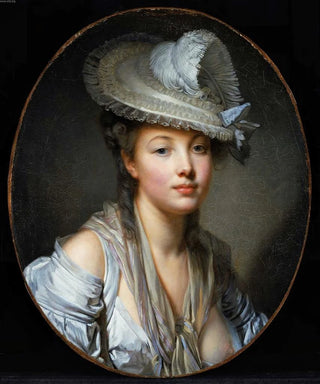Art print | The White Hat - Jean-Baptiste Greuze


View from behind

Frame (optional)
In the world of art, some works transcend time and eras, captivating the gaze and the minds of viewers. "The White Hat," painted by Jean-Baptiste Greuze, is undoubtedly one of those timeless creations that, through its elegance and depth, invites attentive contemplation. This painting, which subtly evokes the nuances of human psychology, transports us to a universe where beauty and emotion meet. The art print of this iconic piece allows appreciation of Greuze's virtuosity, while offering an entry point into exploring universal themes of love, youth, and the human condition.
Style and uniqueness of the work
"The White Hat" stands out for its harmonious composition and subtle use of light. Greuze, master of chiaroscuro, manages to create an intimate atmosphere where every detail contributes to visual storytelling. The central character, delicately highlighted, wears a white hat that symbolizes both purity and the fragility of innocence. The facial features, finely crafted, express a range of emotions from melancholy to joy, making the viewer a confidant in this intimate scene. The soft colors and delicate nuances reinforce the impression of gentleness and lightness, while revealing the artist's technical mastery. This painting is not only a figurative representation but also an exploration of human feelings, a true invitation to reflection.
The artist and his influence
Jean-Baptiste Greuze, an emblematic figure of the 18th century, knew how to mark his era with his innovative approach to genre painting. His talent lies in his ability to capture human emotions with rare intensity, placing the individual at the heart of his works. Through "The White Hat," Greuze illustrates his penchant for portraits of young women, often imbued with a delicacy and sensitivity unique to him. His influence extends beyond his time, inspiring many artists who sought to explore the psychology of characters and to highlight emotional expression in painting. By examining Greuze's work

Matte finish

View from behind

Frame (optional)
In the world of art, some works transcend time and eras, captivating the gaze and the minds of viewers. "The White Hat," painted by Jean-Baptiste Greuze, is undoubtedly one of those timeless creations that, through its elegance and depth, invites attentive contemplation. This painting, which subtly evokes the nuances of human psychology, transports us to a universe where beauty and emotion meet. The art print of this iconic piece allows appreciation of Greuze's virtuosity, while offering an entry point into exploring universal themes of love, youth, and the human condition.
Style and uniqueness of the work
"The White Hat" stands out for its harmonious composition and subtle use of light. Greuze, master of chiaroscuro, manages to create an intimate atmosphere where every detail contributes to visual storytelling. The central character, delicately highlighted, wears a white hat that symbolizes both purity and the fragility of innocence. The facial features, finely crafted, express a range of emotions from melancholy to joy, making the viewer a confidant in this intimate scene. The soft colors and delicate nuances reinforce the impression of gentleness and lightness, while revealing the artist's technical mastery. This painting is not only a figurative representation but also an exploration of human feelings, a true invitation to reflection.
The artist and his influence
Jean-Baptiste Greuze, an emblematic figure of the 18th century, knew how to mark his era with his innovative approach to genre painting. His talent lies in his ability to capture human emotions with rare intensity, placing the individual at the heart of his works. Through "The White Hat," Greuze illustrates his penchant for portraits of young women, often imbued with a delicacy and sensitivity unique to him. His influence extends beyond his time, inspiring many artists who sought to explore the psychology of characters and to highlight emotional expression in painting. By examining Greuze's work






